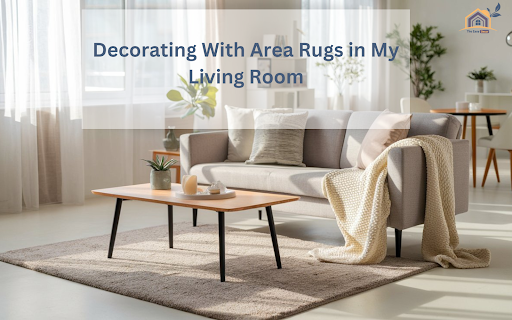Area rugs are a simple yet impactful addition to any living room. They bring warmth, define spaces, and add style to your décor.
Let’s explore how to use them effectively to create a welcoming and comfortable room.
1. Assess Your Space
Understanding your living room’s layout is the first step in choosing an area rug. The size of your rug will depend on the room’s dimensions and furniture arrangement. A well-placed rug can make your space feel cohesive and balanced.
Measuring the Room
Start by measuring the seating area, which is only part of the room. For instance, if your furniture is grouped around a coffee table, ensure the rug is large enough to fit the table and at least the front legs of the surrounding furniture.
Tip: Consider a rug like the Safavieh Hudson Shag Collection Rug for its cozy texture and size options.
2. Define Your Style
Your choice of area rugs reflects your style. Whether you prefer a minimalist look or something more eclectic, there’s a rug to match every taste.
Modern, Traditional, or Eclectic?
Modern rugs often feature geometric patterns or monochromatic designs, while traditional rugs showcase ornate motifs. If you enjoy mixing styles, choose an eclectic rug to bring character to your space. Solid-colored rugs are versatile and pair well with a variety of furniture designs.
3. Choose the Right Material
The material of an area rug affects its appearance, feel, and durability. Select a material that suits your living room’s function and maintenance preferences.
Wool, Cotton, or Synthetic?
Wool rugs are soft and long-lasting, ideal for high-traffic areas. Cotton rugs are lightweight and easy to move around, while synthetic rugs like polypropylene are affordable and stain-resistant, making them great for families or pet owners.
Suggestion: Try the nuLOOM Moroccan Blythe Rug for its durability and stylish design, perfect for busy households.
4. Color and Pattern Selection
The colors and patterns of area rugs can set the tone for your living room. They should complement the room’s existing décor while adding visual interest.
Neutral or Vibrant?
Neutral-toned rugs create a calming atmosphere and allow other elements in the room to shine. Vibrant patterns can make a bold statement and energize the space. Match patterned rugs with solid-colored furniture or vice versa for a balanced look.
5. Placement and Layering
How you position an area rug can influence the flow and functionality of your living room. Thoughtful placement helps anchor your furniture and create a defined seating area.
Tips for Placement
Place the rug so it extends slightly beyond your furniture. For a layered effect, you can add a smaller decorative rug on top of a larger neutral one. This technique works well in small and large spaces, offering a textured, dynamic look.
6. Maintenance Considerations
Keeping your area rugs clean is essential for maintaining their beauty and lifespan. Choose a rug that suits your lifestyle and cleaning habits.
Low-Pile vs. High-Pile Rugs
Low-pile rugs are more straightforward to vacuum and clean, making them a practical choice for families. High-pile rugs, while luxurious, require more effort to maintain. If spills or stains are a concern, consider rugs with stain-resistant treatments.
7. Budget Planning
Area rugs are available at a range of prices, so it’s important to set a budget before you start shopping.
Finding Value
High-quality rugs may have a higher upfront cost but tend to last longer. However, there are affordable options that balance price and durability. Compare different brands and read reviews to make an informed decision.
8. Seasonal Updates
Updating area rugs based on the season can refresh your living room’s look. A simple swap can make the space feel new and inviting.
Seasonal Options
During warmer months, consider lightweight, breathable rugs in light colors. For colder months, switch to thicker, cozier rugs that add warmth and comfort. Proper storage, such as rolling rugs instead of folding, ensures they remain in good condition.
Conclusion
Decorating with area rugs in your living room adds style, comfort, and functionality. You can enhance the space by selecting the right size, material, and design to reflect your personality. Thoughtful placement and regular care will ensure your rugs remain a cherished part of your home décor for years.
FAQs
What is the best size of an area rug for a living room?
The best size depends on your living room layout and furniture arrangement. Typically, an 8×10 or 9×12 rug works well in most living rooms. Ensure the rug anchors your furniture by fitting under the front legs of sofas and chairs.
Should the area rug match the furniture or walls?
An area rug should complement your furniture and walls rather than match them. Neutral rugs pair well with colorful furniture, while vibrant rugs add character to neutral or minimalistic spaces.
How do I maintain an area rug in a high-traffic living room?
Regular vacuuming and spot cleaning are essential for maintaining rugs in high-traffic areas. Choose low-pile or stain-resistant materials for easy upkeep and durability.
Can I layer area rugs in my living room?
Yes, layering area rugs adds depth and texture to your space. Combine a larger neutral rug with a smaller patterned one for a stylish and cozy effect.
What is the best material for an area rug in a living room?
Wool is durable and soft, making it ideal for living rooms. Synthetic materials like polypropylene are great alternatives for budget-friendly, low-maintenance living rooms.



